The huge challenge facing Isle of Wight schools amid falling birth rates and the steep decline in pupil numbers is laid bare in the Island’s first mainstream school place planning strategy, published today (Wednesday) by the Isle of Wight Council.
The draft strategy sets out why the authority must tackle the high number of surplus places within schools to ensure they are adequately funded and, most crucially, Isle of Wight children and young people receive the world-class education they deserve.
New Draft Education Strategy
The strategy also supports, and indeed underpins, the new Draft Education Strategy, the council’s ambitious blueprint for school improvement launched earlier this week with the clear goal of turning around an underperforming school system to secure a brighter future for Isle of Wight youngsters.
But it’s not just the council which believes immediate action is needed to pull the Isle of Wight out of the bottom ten per cent of local authorities for key performance indicators — it’s the people who best understand education on the Island: our dedicated school leaders.
Many headteachers and school governors agree
The voices of many headteachers and school governors have been raised as one on this issue, asking for a clear strategic vision for the whole Island.
As far back as 2022, they warned that keeping too many schools open risked condemning pupils to a mediocre education.
The Isle of Wight Headteacher Executive wrote,
“For the school system on the Island to thrive and children to receive the education they deserve, it is imperative that schools are full and that there is a good mix of larger (two form entry) and smaller primary schools in the right geographic locations, which feed into appropriately sized secondary provision.
“The Island then has a chance to create a self-sustaining system where financial viability and high-quality education can be delivered hand in hand.”
Top priority for Islanders
Islanders too ranked ‘quality of education’ as their top priority during engagement meetings held across the Island by the council’s newly-installed children’s services team to provide an understanding of the reasons as to why change is required.
Since taking over from Hampshire in February, the team has visited every Island school and worked closely with head teachers and governors to understand what is important to them.
Why change is needed
Nationally, birth rates have reduced to their lowest level since 1941. The drop is having a significant impact on the Island where, by 2027, just 920 children are expected to start reception — a considerable drop from 1,404 in 2018.
As of October 2023, there were 1,898 unfilled school places across the Island. By September 2027, this number is forecast to rise to 3,056.
Stark financial impact
The financial impact is stark and severe: for every empty seat, schools lose more than £4,500, affecting resources, opportunities and the quality of education children receive. The ongoing trend indicates that by March 2027, 22 primary schools may face budget deficits, potentially amounting to a cumulative £7.4 million or more.
Surplus places mean schools struggle to maintain a broad and high-quality curriculum. Falling rolls also make planning and staffing decisions difficult, with schools potentially having to make year on year redundancies or having to restructure.
Carter: Ensuring every child on the Isle of Wight receives the best possible education
Naomi Carter, the council’s service director for education, inclusion and access, said,
“Addressing these issues is not just about numbers, it’s about ensuring every child on the Isle of Wight receives the best possible education.
“We are committed to making these necessary changes for the future of our children.”
Next steps
Today’s report sets out how school places will be managed to ensure parents and carers of all children living on the Island can secure a good school place within a reasonable distance of home.
It identifies the total number of empty school places in each area of the Island and proposes a reduction, taking into account such factors as new housing developments, while maintaining some surplus to accommodate potential future growth and parental choice.
SEND provision
At the same time, the strategy identifies the positive opportunity to expand the provision of high-quality education for children and young people with special educational needs and disabilities (SEND) — one of five key priorities within the Draft Education Strategy.
By 2030, the council’s vision is that all children on the Island will be equipped with the skills and aspirations to access opportunities of their choice.
Bacon: A clear school place planning strategy is required
Councillor Jonathan Bacon, Cabinet member for children’s services, explained,
“With a steep decline in births a clear school place planning strategy is required.
“This will see a reduction in the number of school places across the Island to respond to falling birth rate, but this will enable our remaining schools to be in the best possible position to improve outcomes for our children and young people by giving our school system and those within it the security that is desperately needed.
“It is true that there has been a delay in bringing this forward but this has been due to the need to get a fuller understanding of how education standards on the Island can be improved and how place planning fits within this aim.
“We also now have the benefit of a wholly Island-based education team at County Hall who have been able to focus exclusively on dealing with these issues in a way that best helps Island children and we also have the benefit of the confidence that this change is giving to all involved in this process.”
The draft strategy will be considered through Cabinet on Thursday, 18th July and, if approved, a detailed review will start during the summer to identify how the council propose to address the level of surplus places and identify what this means for the future of schools on the Island.
This gives officers, councillors, and stakeholders an opportunity to listen and then act on feedback, which in turn will help to take the draft strategy to the next stage in its adoption and implementation process.
All Islanders are being encouraged to get involved in this consultation by emailing [email protected]
More information is available on the council’s ‘Island education plans and policies’ web pages while the School Place Planning Cabinet report can also be viewed online.
News shared by Isle of Wight council press office, in their own words. Ed





